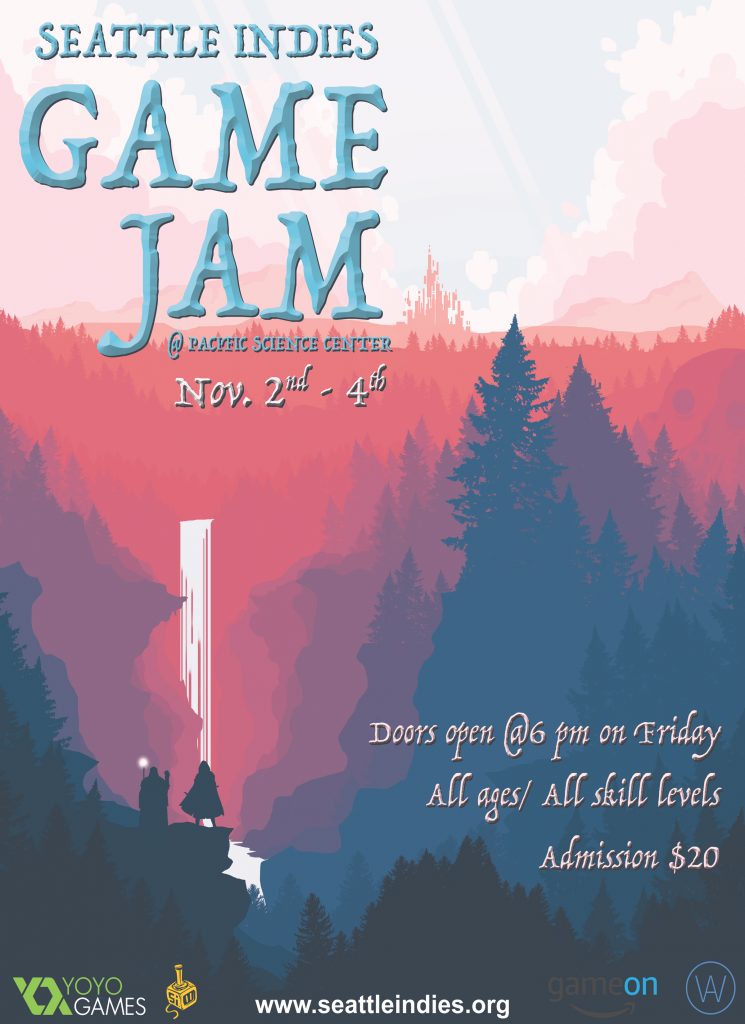
Seattle Indies Game Jam 2018 Recap
Tagged: game jams
Written by Anthony Ritchey, Poster art by Austin Whitaker, Photos by Adrian Sotomayor
– – –
The second annual Seattle Indies Game Jam arrived at many unexpected results!
The Seattle Indies Game Jam 2018 was created for and by the Seattle Indies community. Game Jam, with the hashtag moniker #sigj2018 and hosted in the Ackerley Family Exhibit Gallery of Pacific Science Center, was a collaboration among over 100 videogame developers and curious minds of various technical or creative disciplines also called “game jammers.” Game jammers met and built 23 games in teams, or individually, over the course of two days – from 7 PM on Friday November 2nd to 6 PM on Sunday November 4th – based around a central theme: Unexpected Results.
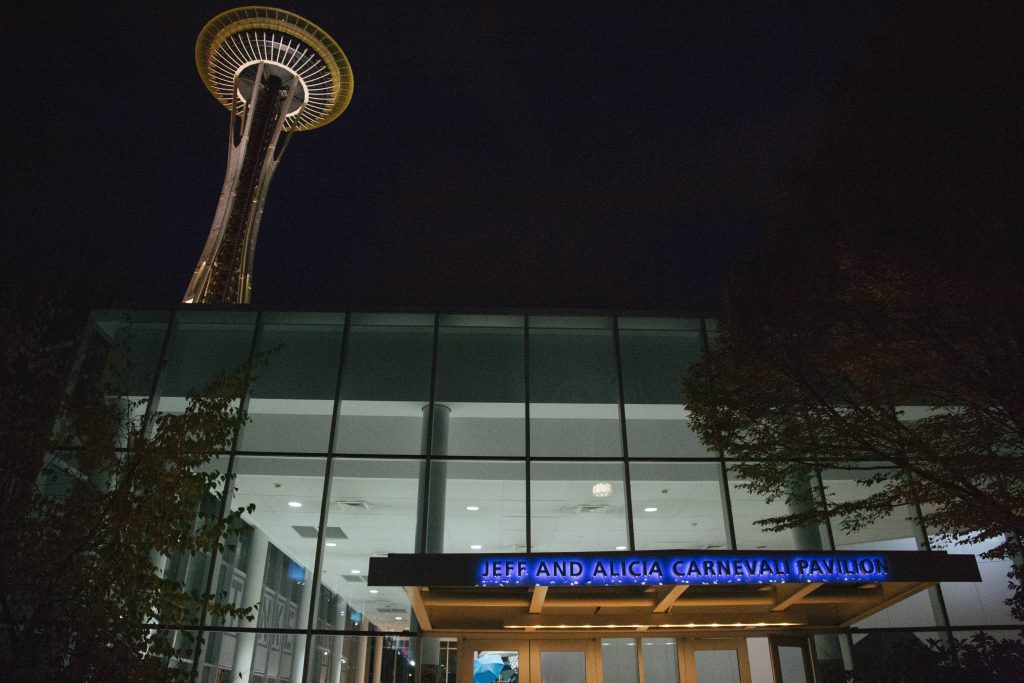
Of the event, which sold out early, Seattle Indies Vice President Tim Cullings said, “close to half of the jammers tonight were first-timers, and most of those were first timers for Seattle Indies as well.” Games made in game jams can usually be played in anywhere between 5-minute escapes to multiple-hour multiplayer games and are usually short, experimental games that, even without the theme of Unexpected Results, are more about trying out a single technical or creative idea than accomplishing anything big.
The game jam location and time frame can change aspects of game development in multiple ways. The location can affect the productivity, motivations, and creativity of game jammers with Pacific Science Center being a venue that consistently inspires creativity for people of all ages! The time format of two days inspires bursts of creativity. On Friday night, everyone was ready to go and worked well into the night. Some teams were awake as late as 4 AM on Saturday morning, then back to work at 8 AM, and working until 3 AM on Sunday morning. Sunday afternoon was crunch time to ensure games could arrive at a “minimum viable product” state for publication on the Seattle Indies itch.io page.
Additionally, the limited window for creating a videogame can change development workflow. The focus isn’t on polished perfection, rather, creating a functioning minimum viable product before the deadline. Game jammers must balance creating an ambitious enough project to impress while completing their game on time! Some programmers will spend time after the game jam to polish their games and publish to other distribution platforms, while others will move on after completing the project. As Tim clarified, game jammers “will retain the rights in case they want to sell the rights to their games on any sort of gaming platform, but most just want to work on games for fun.” This decision depends on the popular reception and of course the game jammers themselves.
Game jams, like the Seattle Indies Game Jam, are a microcosm for how larger-scale game developments operate. They are a brilliant opportunity to test the waters in building games over the course of a radically short period of time. Many of the same development cycles featured above appear in larger, AAA studios – coming up with ideas, brainstorming, overcoming problems of all sorts, the resilience to push through especially in the final hours before the deadline, and all of the “unexpected results” that happen along the way!
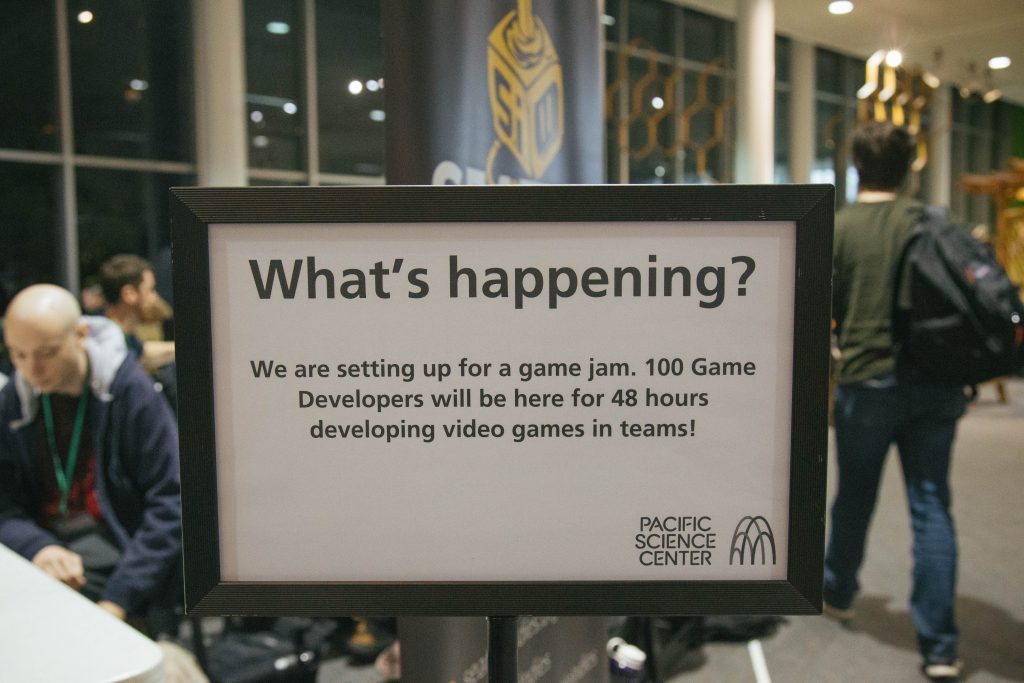
Tim and Daniel Rother of Pacific Science Center’s Tinker Tank exhibit both encouraged game jammers throughout the event with two main thoughts. First, since the game jam was hosted during museum hours, we were encouraged to interact with inquisitive kids and family, because the jam was a living exhibit itself, showing museum guests what the game dev process looks like in action. The game jammers seated around the edge of the work area often fielded questions respectfully and professionally from children and family about the games they were working on. Second, the Seattle Indies fosters an environment where it’s OK to fail, as long as you ask for help and pick yourself back up. Mentors, volunteers, and other game jammers were readily available throughout Game Jam to assist with logistical, technical, or programming issues.
Pacific Science Center, similarly, ensured a secure space for the game jammers. During the day, there were enough people in the main area so game jammers could go out to lunch and not have to worry about their personal equipment. During the night, a security detail monitored the building and grounds. There were also Pacific Science Center employees available – Michael and Julia – throughout the night hours on Friday and Saturday to ensure the in the pre-approved sleeping areas within the building remained safe and secure.
Most everyone that stayed overnight took public transportation or private transportation to and from the Seattle Center. Whereas people that drove home in the evening would park in nearby parking garages or on the street.
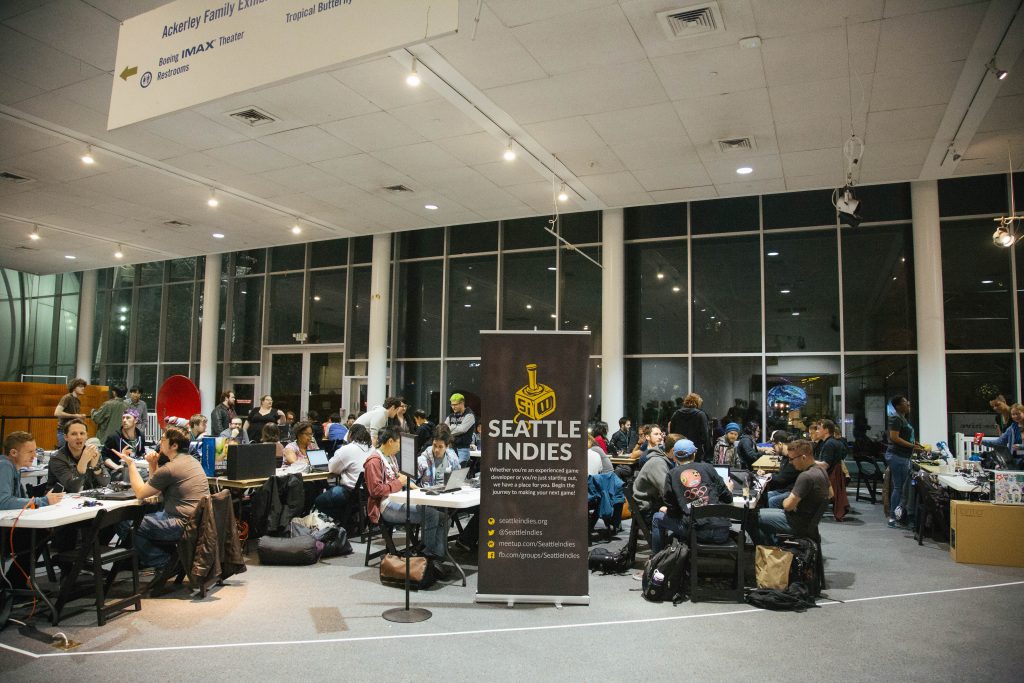
In the weeks leading up to the Game Jam, the Seattle Indies made a series of announcements on the Facebook and Meetup pages, first asking for all people to go through a background check to ensure safety as a top priority for game jammers and guests, then posting a link to a dedicated Discord channel to organize. There was a general chatroom for everyone and a looking for group chatroom for people to team up in advance.
Most teams were formed spontaneously. “Within the Seattle indie community and the tech community many people know a decent number of the people attending,” explained Ket Ng with the Seattle Indies, however many of the groups and individuals making these games had never worked together prior to Friday evening. Around half were active in the Seattle Indies scene, working on other games in proximity to other game developers, but had never found the opportunity to work together until this Game Jam.
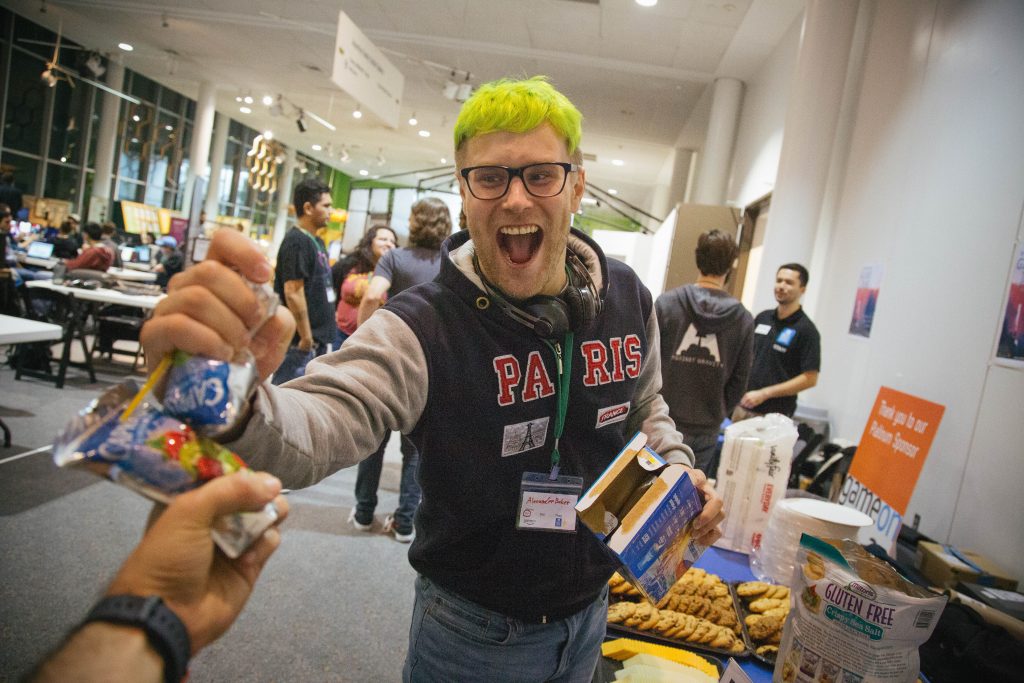
STAFF
Seattle Indies: Tim Cullings
Seattle Center: Daniel Rother and the courteous overnight staff, including Michael and Julia
Judges: Brooke Branch, Fernando Reyes, Rabecca Rocha, Ryan Cousins, and Timothy Stanton-Davis

Seattle Indies Volunteers: Adrian Sotomayor (photographer), Andrew McDonald (general assistance), Anthony Ritchey (text journalist), Bilgem Cakir (video journalist), Chris Dougherty (programming assistance), Ket Ng (general assistance), and William Pheloung (programming assistance)
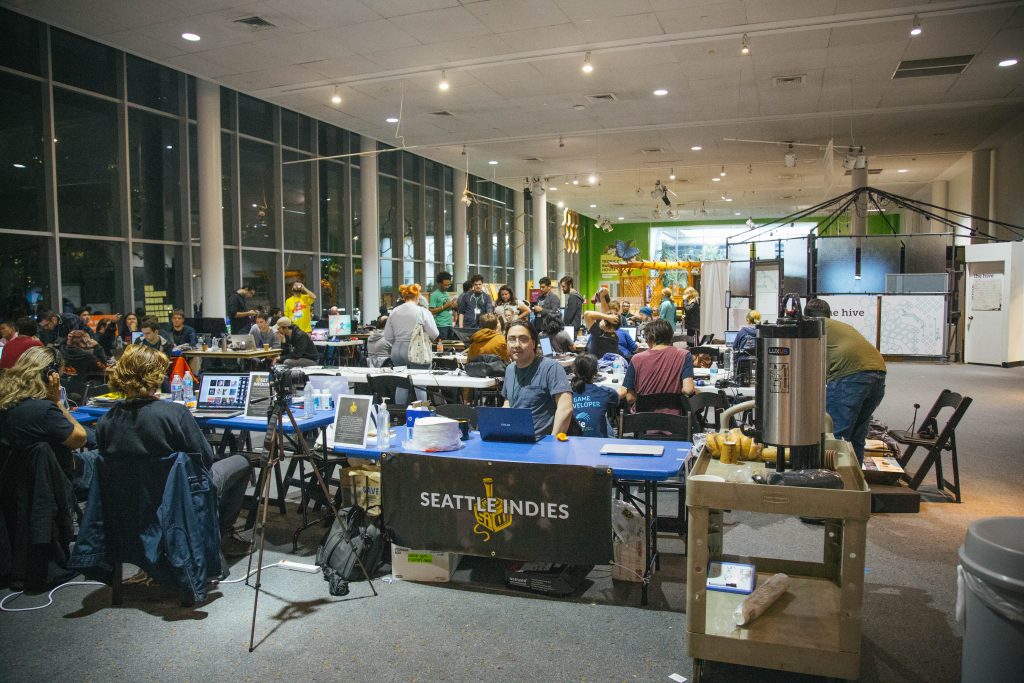
SUBMISSIONS AND DEVELOPER(S)
- A Wizard Fighting Cowboys: Darsh, Jacob, Nathan, Robert Rood, and team
- Avant Garde: Amy Sterling (2D), Isaiah Mann (Engineering), Jackson Van Dyck (Engineering), Michael Pacheco (3D), and Spencer Edgers (Audio)
- Baffled Brawl: Erfan Dastournejad (Art/Design), Kasra Rahimi (Developer), and Pouria Ghadimi (Developer)
- Bug Light Saloon: Arsen Gogeshvili, David Yamato, John Michael Hunt, Nick Wrycha, and Po-Chen Yang
- CreateTech: Ashley (Programming/Art) and Daniel (Story/Design)
- Dead Signal: Arsen Gogeshvili (Sound), Ed Lu (Programming), Nick Amlag (Art/Design)
- Deleveled: Kyle Donnelly and Patrick Nance
- Dr. Sticky’s Spawn Salon: Brendan, David, Jeff, Marshall, Nina
- Dr. oFFbEET: Ben, Clinton, Hayley, Landon and team
- Elemental Forest: Beverly, Budi, and Jami
- Goblungee: Cameron Shimmin (Sound), Julie Godwin (Art), and Olin Olmstead (Programming)
- Goodnight, Rowan: Andrew Hermus (Programming), Andrew Hung (Programming), Robert Ackley (Programming), Sarah Belhumeur (Art), and Steven Garcia (Music/SFX)
- Hello World: Craig (Programming) and JT (Concepts)
- Hooked: ChPe Studio
- InfiniFarm: Adina Shanholtz (Programming), Lynn Cyrin (Programming), Rachél Bazelais (Programming), Sarah Sexton (Programming), Tori Jean (Art), and Spencer Edgers (Music)
- Knockout Mouse: Arsen Gogeshvili (Sound), Cami Woodruff (Art), John Bonham (Programming), and Justin Camelia (Programming)
- Magic Mixer: Alberto and Yazmery
- Of Cats and Geckos: Alex Baker (Art), Max Sandler (Programming/Design), Riley Murphy (Story), and Taylor Ambrosio Wood (Music/Audio)
- One Click Pony: Ben Schiffler, Theo Chin, and Xing Guo – all jammers worked remote
- Raking It In: “Witch Warlock”
- Smiling at Neighbors: Stephanie Kwak (Design), Zomawia Sailo (Programmer)
- Time Mashine: Amanda (Programming), Forrest (Programming), Ray (Programming), Rory (Music), John (Art)
- Unexpectigun: Robby Zinchak (Everything), John Michael Hunt (SFX + Music)
[Writer’s Note: The development production cycle notes below were based on my observations while on-site, with some feedback provided during the editing process. I talked with as many people I could. Unfortunately, I was not able to talk or interview with everyone. I feel bad that I wasn’t able to meet or talk with everyone. I really do!]
FRIDAY AFTERNOON
Volunteers arrived early to set up tables, chairs, and networking equipment before the official arrival time of 6 PM for game jammers.
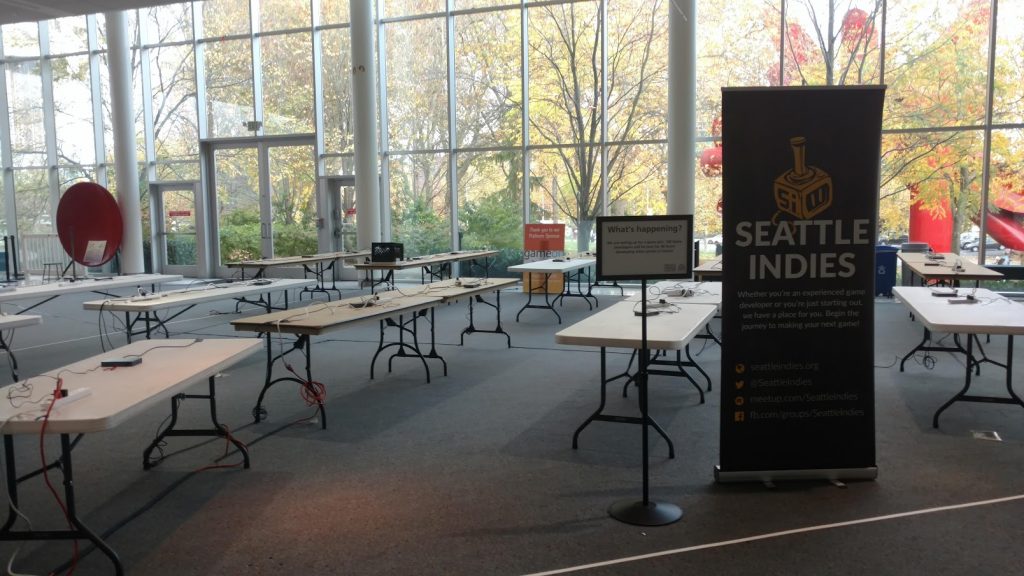
FRIDAY, 6 PM
Game jammers unloaded in their equipment and prepped their collaborative tools (laptops, desktop computers, tablets, and VR stations). They also checked in with their teams, if they had already coordinated in advance via the Discord or other social media. If not, game jammers met others based on common technology interests or if they recognized their friends from within the vibrant, inclusive Seattle Indies community.
FRIDAY, 7 PM
Security secured personal property while everyone walked over to the Auditorium for the kick-off presentation. This announcement ceremony was presented by Tim, along with a quick word from Abdullah Hamed, one of the Game Jam sponsors promoting Amazon GameOn.
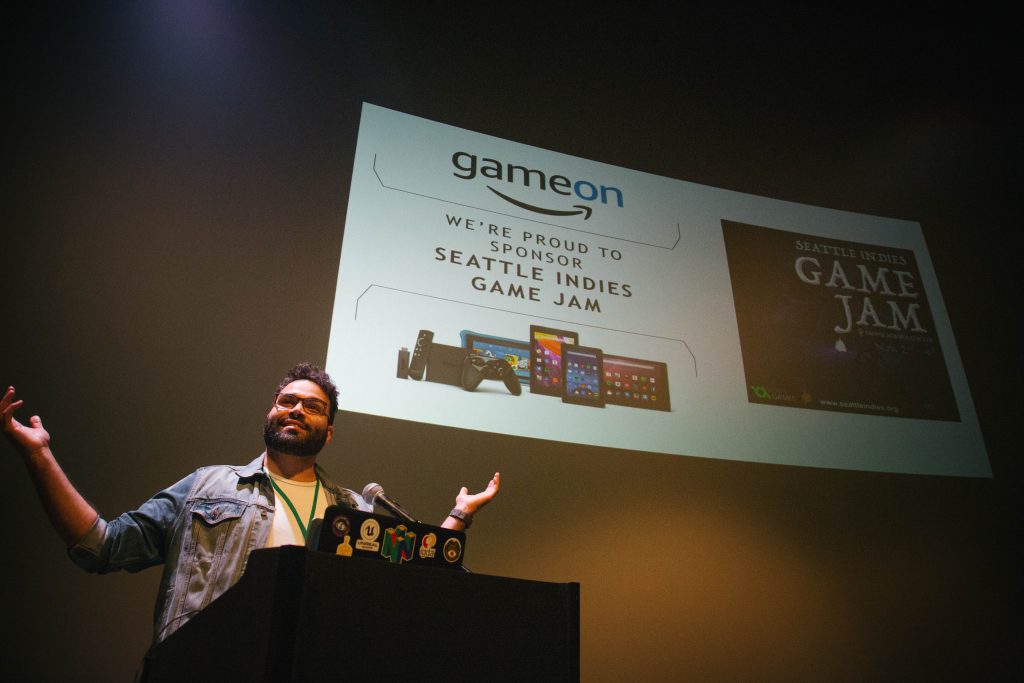
The focus of the presentation was to ensure everyone on the same page before starting:
– Policies
Tim reminded us that Game Jam was hosted during museum hours. We were encouraged to interact with inquisitive kids and family because “you are an exhibit.” We covered logistics about building access both during museum hours and outside of museum hours, locations of bathrooms, and sleeping areas for both outside of museum hours and during museum hours.
– “Word from our Sponsors”
YoYo Games provided GameMaker keys for use throughout the weekend. Abdullah, a representative from Amazon AppStore and member of the Seattle Indies community, went on-stage to explain that Amazon is working on a new cross-platform competitive gaming platform called GameOn. He thanked everyone for participating, was excited to see the results of the Game Jam on Sunday, and encouraged game jammers to consider uploading to their platform.”
– Theme: Unexpected Results
There were a handful of themes suggested by our Patreon donors and voted on by members of the community in the month leading up to the jam. The winner of the theme was “Unexpected Results,” which was presented in a humorously unexpected countdown fashion.
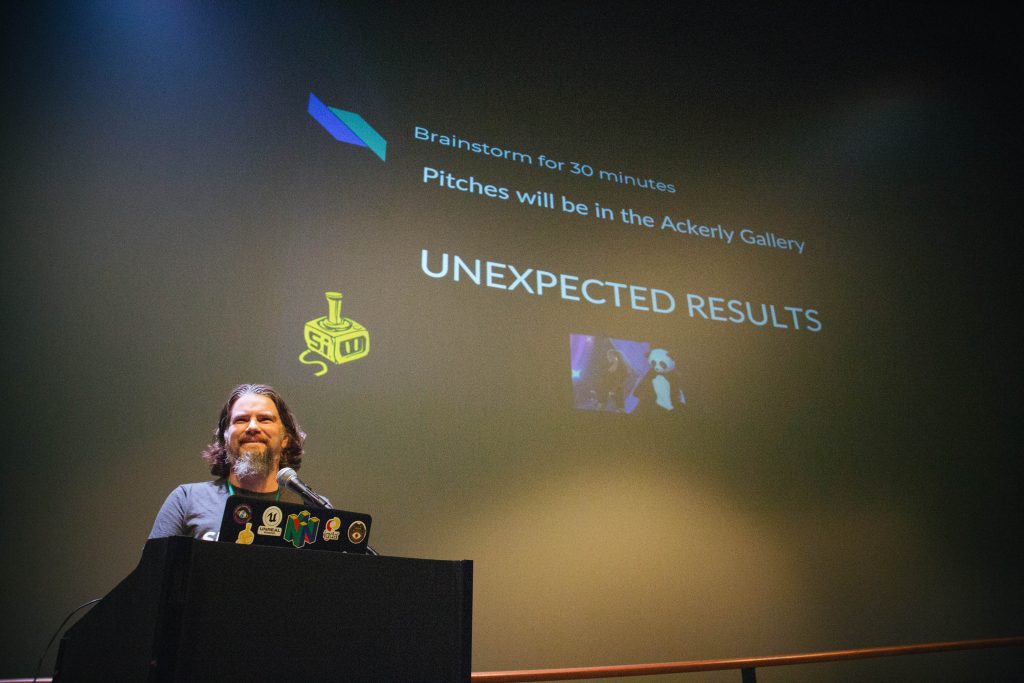
– Failure is OK
Tim reminded game jammers that failure is OK. “We might shoot for the moon and probably won’t make it.” This speech, along with the hallway leading to the Ackerley Family Exhibit Gallery lined with “failed” visionaries from Albert Einstein to Emily Dickinson, fostered a creative, low-pressure environment for game jammers to do their best. Tim concluded this section by saying “the important part is that we all work hard as teams to deliver the best possible product.”
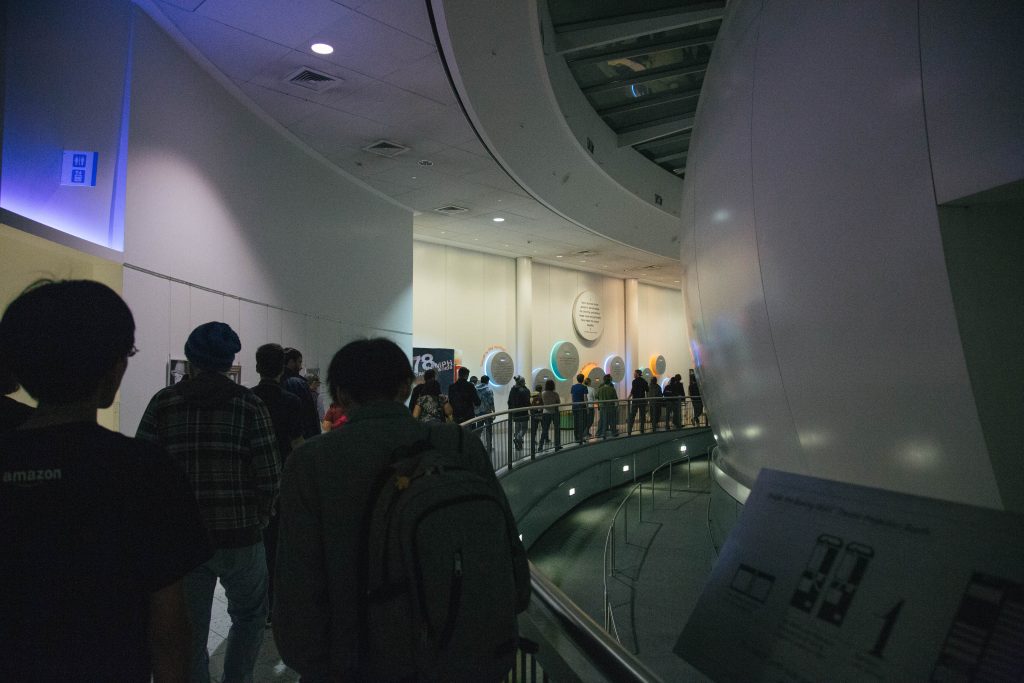
– Presentations
Tim concluded the presentation with a note that on Sunday evening, after dinner, all of the games would be presented in the auditorium and streamed on Twitch and later uploaded to Youtube.
FRIDAY, 8 PM
Everyone got to work! This was the time for pre-established teams to start work on their game based around the theme of Unexpected Results, or for jammers in need of teammates or ideas to collaborate. Mentors, hosts, and jammers met in front of a digital whiteboard to brainstorm and present ideas. After each presentation, Michael with Pacific Science Center and Ket with the Seattle Indies helped facilitate uploading these requests to the Looking For Group section of the #SIGJ2018 Discord:
– Beverly presented the idea of “unexpected results in a room where you’re tasked with doing something simple in VR Oculus Go.” Her team had a coder, Unity developer, sound and VR experts. They needed a 3D modeler. This game became Elemental Forest.
– Cami presented the idea of a “lab rat reverse gravity disaster party.” Her team had a 2D artist, writers, two programmers, and sound designer, and needed a 3D background artist/modeler and level designer. This game became Knockout Mouse.
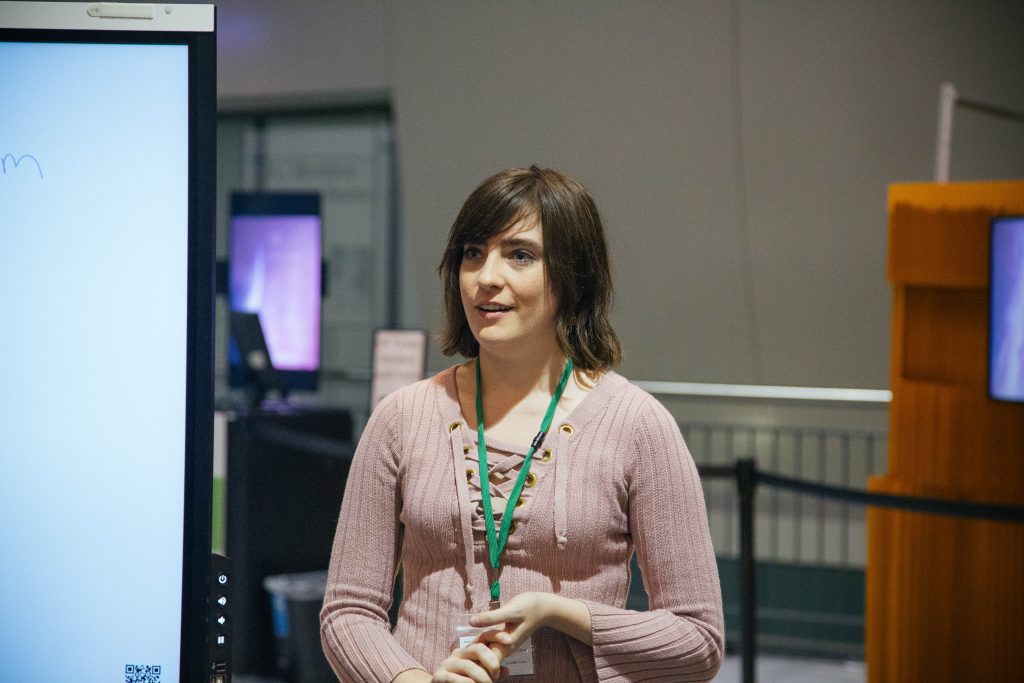
– Clinton presented the idea of an “off-rhythm rhythm game where you’d heal people with bullets and it’d have crazy sound effects.” This game became Dr. oFFbEET.
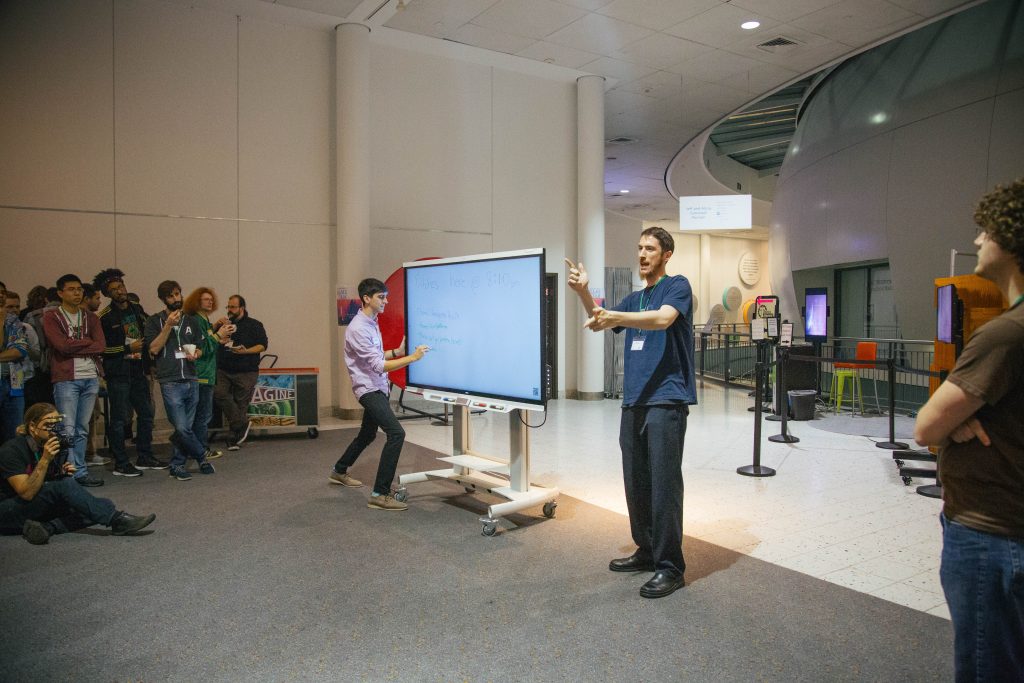
– Darsh presented the idea of a “random box fighter.” Darsh had a programmer and programmer/artist/modeler, but needed everything else. He ended up joining the team working on A Wizard Fighting Cowboys, which was an idea that Rob presented near the end of the pitching phase.
– David and Po-Chen presented the idea of a “bar fight game.” They had collaborated together in the past and had 2D and Unity experience, but needed a composer, animator, and programmer. They used their #bar-fight-game channel to build the game that became Bug Light Saloon.
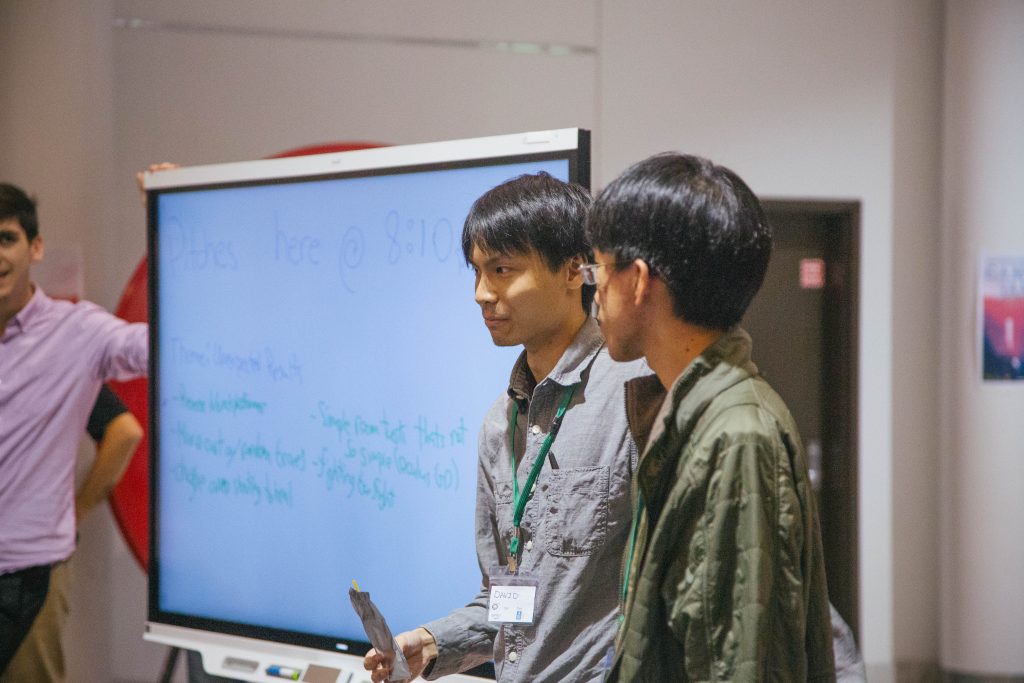
– Olin presented the idea of a “bungee jump into the abyss and unexpected things happen.” He had a programmer (Olin) and music (Cameron), but needed an artist (Julie). This game became Goblungee.
– Spencer presented the idea of a “random generated interactive art piece.” Spencer composed and did sound design, but needed everything else. This game became Avant Garde.
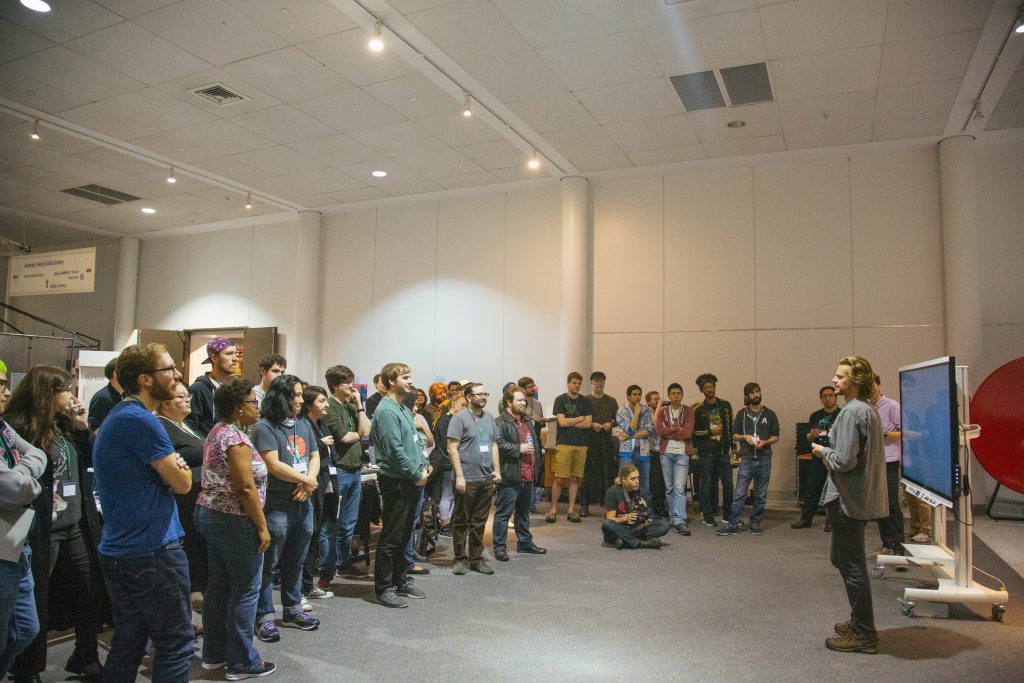
Game jammers also offered up collaboration opportunities:
– Audio developers, like on-site game jammers Arsen and Jacob, along with myriad audio developers working remotely to provide audio advice or assets for multiple games
– Terence is a professional game artist and designer that joined the Game Jam to work solo to learn some aspects of programming, but wanted to use this opportunity to mentor and collaborate with other game jammers.
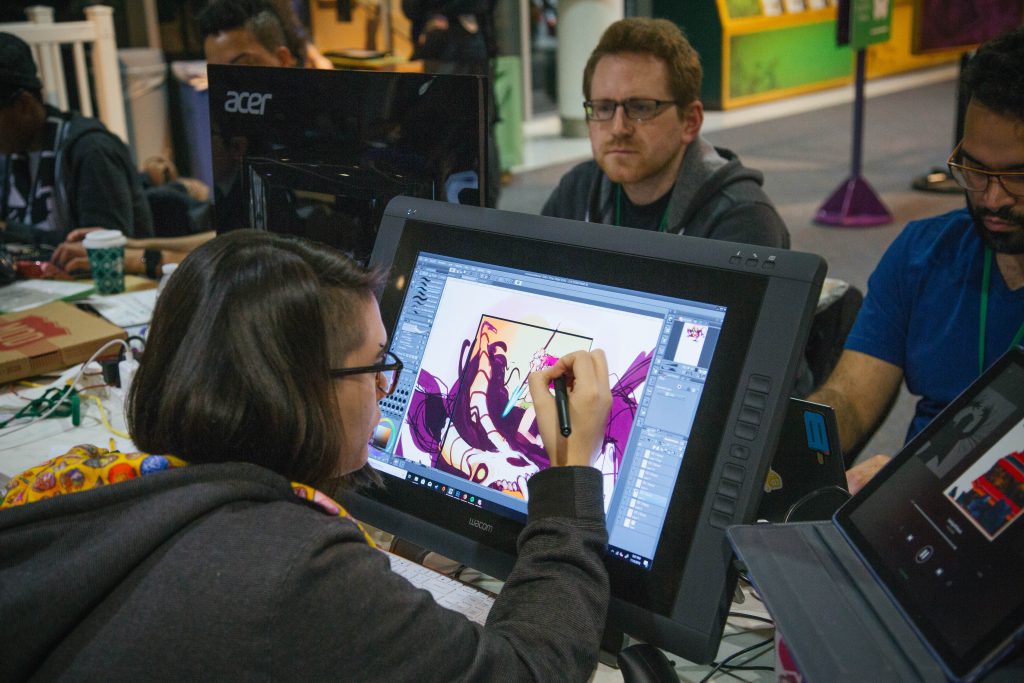
FRIDAY, 9 PM
Mentors toured around the existing teams to make sure everyone had the preliminary resources they needed. People stopped by the volunteer area on their first break, after working on their project for a few hours, to either talk about their project’s status or just to take their mind off the work. Everyone explained to some degree that their projects were in experimental phases. As the evening progressed, the ideas and games of the jammers solidified:
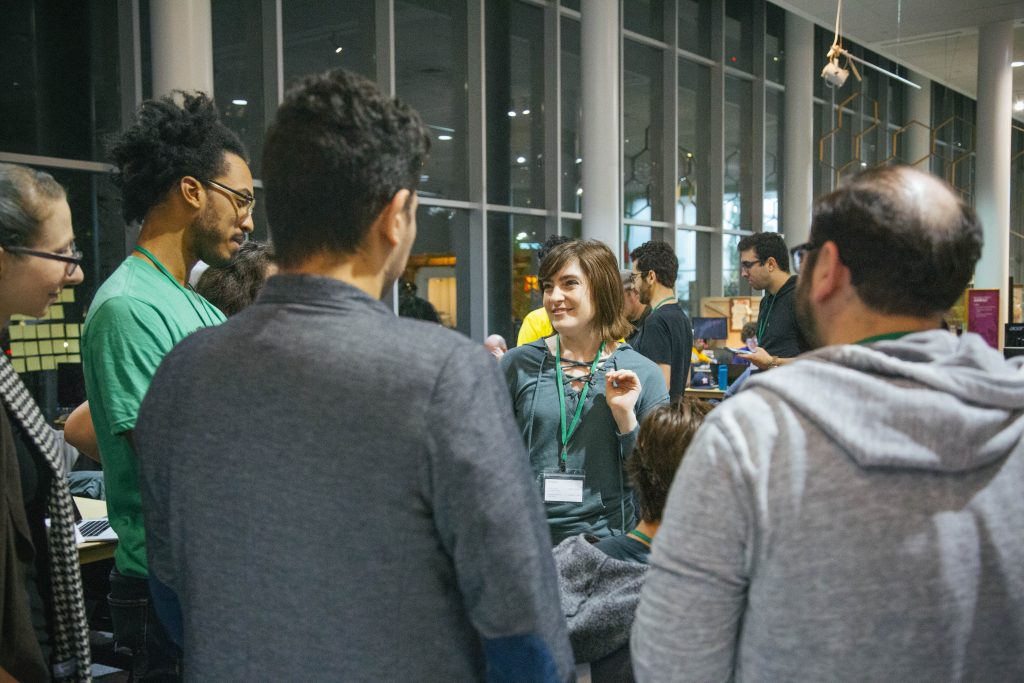
This five-person group consisted of game jammers that had all wanted to work with each other for a while. Everyone had worked in other game jams before and they collectively took their successes and the experiences of not quite failures to have an accurate scope of working with the two-day time limit of the Game Jam.
Steven, music and sound designer for the project and friend/frequent collaborator with some of the Seattle Indies volunteers, talked about the intricacies of game jams on his first break. The idea is that within a 48-hour framework, the game should be completed to a minimum viable state within the first 24 hours, leaving the remaining time to bug fix and polish.
Steven explained: “It’s better to make the mechanics easy rather than overtaxing developers with something too big. People want to make a Mario Odyssey game, but end up spinning their wheels the whole time because they can kinda program it, but can’t. Instead, they should say ‘I think I can do that’ and work toward that. We also don’t want to have any of the gameplay mechanics to be unexpected. We’d rather that the narrative is unexpected.”
They wanted to work on a game that was focused on positivity and fun rather than an overly complex game. Their final idea was something they could implement easily. This way, as Steven continued, “if we get all the necessary, easy stuff out of the way, then that gives us more room for playtesting. We’ll need as much time for balancing. We want to have a minimum viable product by tomorrow so we can spend the rest of the time testing.”
This was another group that went with a similarly small-in-scope game. The plot from the beginning was about a child in a time machine cardboard box. The child “will move across different time periods, conveyed in a bathroom, and will be implemented using VR technology. The game will be a scavenger hunt, with about 2 to 3 rooms,” said 3D modeler Josh. They intended to have the game complete by Saturday evening, trimmed and ready to go, so they could work all through Sunday on testing for bugs and implementing any stretch goals.
Josh came up with the idea for their game based on the music they wanted to implement. The idea evolved into a puzzle room with a kid with a simple narrative structure and a show, don’t tell approach to storytelling. VR programmer and AIE student Ray said that “implementing a UI dialog system would be too complicated for this project,” since their aim is a 5-minute or 10-minute game. “Depending on the results of the game,” Ray estimated that they “could have a narrator with voice acting, if there’s time.”
The team chose the VR platform based around the team’s mutual interest in VR, starting with a recent AR/VR Game Jam. Ray explained that “currently, VR technology runs on three different platforms: Microsoft’s Windows Mixed Reality, Oculus Rift, and HTC Vive. Each platform runs in a slightly different programming language, so to overcome this challenge, we are programming in a language called VRTK or Virtual Reality Toolkit, which can implement the code in all three languages.” Amanda continued by saying that they “will be mindful of VR motion sickness.”
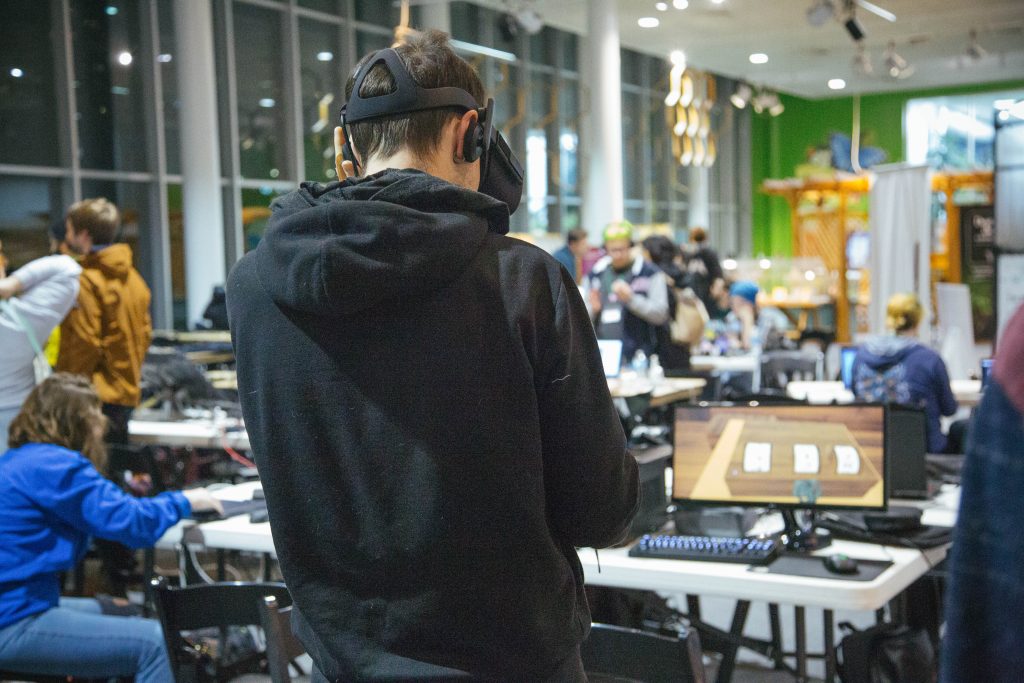
Lynn and Adina pitched the idea of a farming simulator game. Sarah joined their group and suggested they could use her previous experience on an infinite runner game she had developed in Unity. Together with Tori and Rachél, the team came up with the idea of, as Sarah summarized, “endless runner where the player must fertilize plots, sow seeds, and water plants, with the goal to collect points and grow some… unexpected results!”
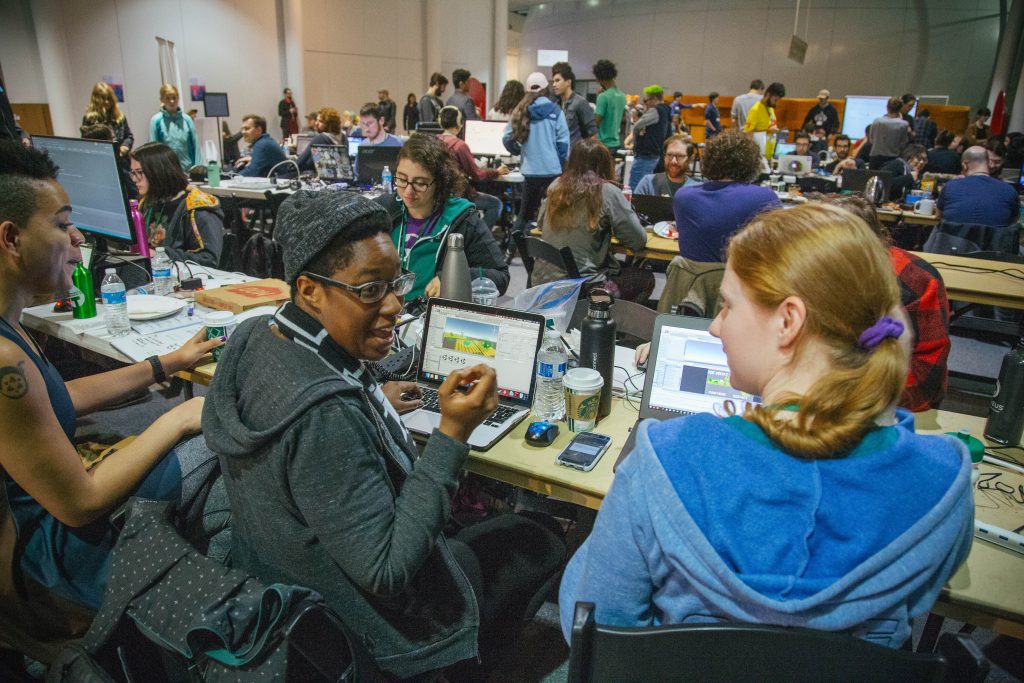
Olin, Cameron, and Jules all worked in various parts of the work area. Olin talked on behalf of the team: “Cameron originally came up with the idea for a bungee jumping game. The unexpected part would be that you can’t actually see inside the dark abyss that you are bungee jumping into,” and with the idea in mind, he and Cameron “hammered out details that included picking up random objects in the darkness and then resurfacing to the light only to find that things are not as they once were. You then have a split second to do something with that object before quickly plummeting back down into the dark abyss.”
With the game design ideas in place, they went to the Discord channel to find an artist. Olin continued: “we found Jules, who came to the jam as a solo artist with no team. She had never worked on a game before but had very high-quality art. I knew we could collaborate with her. Jules liked the game idea and built the goblin story on top of the mechanics that we designed.”
A duo of third-shift programmers – TJ and Craig – worked on a game with narrative branching options in Blueprint [Kismet] and were implementing it within the Unreal engine. Craig explained their initial plans: “The player character walks up to floating text and reads the dialog. The unexpected element is that the dialog,” which during this conversation they didn’t have completely ironed out, “would be something that would be initially confusing until the primary idea is revealed to the player.” This was their first time at a Seattle Indies Game Jam, and as TJ added, “we’ve been talking about working on a game for a while, but never got around to it.”
At midnight, Michael with Pacific Science Center announced the policies for sleeping arrangements, and by 3 AM, there were still two solo programmers and three groups of programmers hard at work.
SATURDAY, 8 AM
Many teams woke up from their on-site sleeping quarters or filtered in from home. Some teams weren’t confident about where they were at with their games. Some game developers had run into unexpected issues that mentors, upon arriving, were able to help address.
Steven worked from his home studio on the sound and music assets for a majority of the day, while the remainder of the team worked at Pacific Science Center. Robert explained that: “the previous night, our team continued brainstorming and comparing alternative ideas after pitches. Once we settled on a basic idea, Steven and I continued hashing out the details of our game design (e.g. considering how to communicate to the player how to progress without explicit text) past midnight, while the rest of the team began laying the foundation of the game (e.g. Andrew Hung got some basic movement and object interactions set up in the code, and Sarah Belhumeur began modeling the room and some of the first objects). By the next morning, we able to begin testing with the basic mechanics and start integrating 3D assets and sound by the afternoon.”
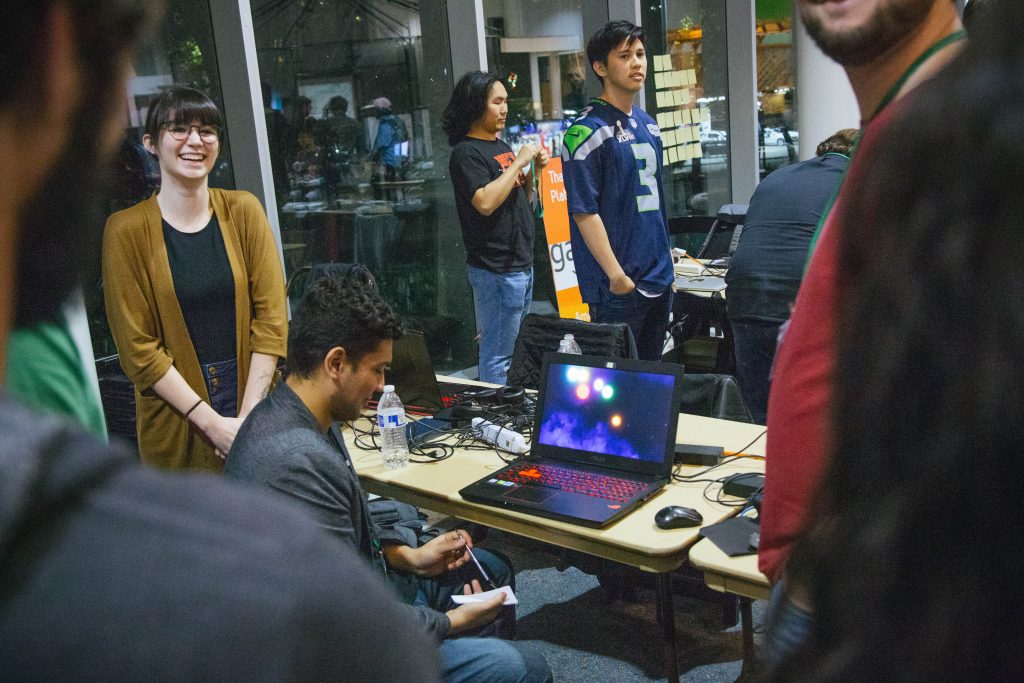
Pouria introduced the game, tentatively called “Space Arena,” during a quick break from troubleshooting a controller mapping issue, as “an arena with portals where you control a ball that goes between portals. The unexpected element is that the player will go to random portals on the level to avoid their opponents.”
Pouria and Efran had worked on an augmented reality card game project before but had not worked with Kasra. Kasra won two game jam events in the past, and as Pouria said, “we got along immediately!” They used the window of the room as a Scrum board with post-it notes to brainstorm. Ehran said, “we came up with ideas for 4 hours last night before we began working today. We generated 75 ideas and narrowed it down to 34 ideas, then 11, and then the idea that was easiest to do!” Ehran continued by providing some context: they’ll explore some of the additional ideas they brainstormed after they completed the core game mechanics.
Once the game jam is over, Pouria said: “if this game turns into a good product, we may polish the game and publish it on GameOn.” Pouria explored the idea that Abdullah may be able to provide consulting or advising for getting games fast-tracked onto the GameOn platform.
Similarly, Sarah explained that their team “utilized the Agile Method to develop as a group, encouraging stand-up meetings at the start of every “sprint” workload.” This combination of Agile, stand-up meetings, and previous game jam experiences allowed them to remain hyper-focused throughout development and was “how we stayed on the same page about who was working on what task, what was blocking development, and what everyone needed to do next.”
SATURDAY, 10 AM
Guests started to filter into Pacific Science Center. The event organizers brought in breakfast – bagels, pastries, and coffee – for game jammers and volunteers. As game jammers stopped over to pick up breakfast, they all felt confident about their games. They were taking positive steps throughout the evening and early morning to brainstorm ideas and any issues that popped up seemed to get ironed out quickly. Many game jammers seemed confident that they would be on track to finish their projects on time. Everything seemed great!
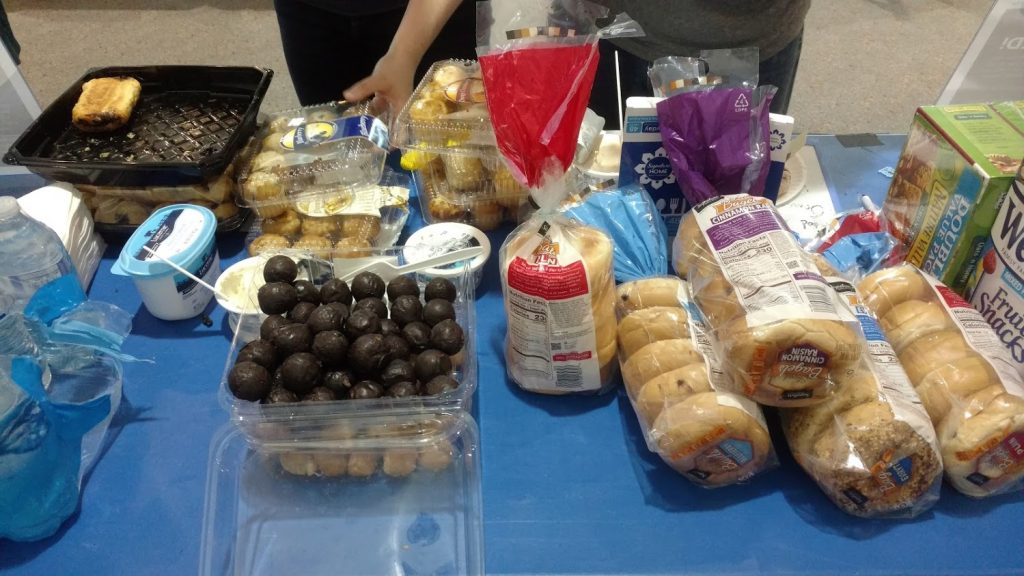
SATURDAY, NOON
Some of the volunteers and organizers suspected that this overwhelmingly positive confidence level from game jammers was more because they stopped over after celebrating a minor/major milestone or when they needed to take a break, rather than an actual overall uptick in progress. A few of the game jammers that were friends with the Seattle Indies volunteers confirmed this to be true.
To explore this point, three of the interruptions highlighted in these development logs did break some of the game jammer’s concentrations mid-project, and interviewing game jammers mid-production did reveal more information about problems they were encountering. With this in mind, there was a respectful balance in gathering information and respecting personal space, because, for example, game jammers weren’t disrupted if they were intently focused on their screens.
Pacific Science Center guests and staff alike were interested in the development of the games. Guests, in particular, had cursory glances, were curious, and inquisitive questions for the volunteers. Not many at this point had any extensive sit-down conversations with game jammers, but that might be expected. Everyone at the game jam is focused on what they’re working on – whether programming, art, sound design, or bug testing – so they weren’t likely to make eye contact or try to sell their game at this point.
SATURDAY, 4 PM
Seattle Indies volunteers Bilgem and Anthony interviewed over twelve game jammers, judges, and Tim. Bilgem brought a video camera and Anthony conducted the interviews asking, primarily, three questions to game jammers:
- What do you like videogames?
- What is your favorite part of game jams?
- What do you like about the Seattle Indies?
Tim and the mentors received more specific questions, particularly in regards to volunteering for this event, teaching other developers, producing games, and more. These interviews are part of an upcoming documentary produced by the Seattle Indies!
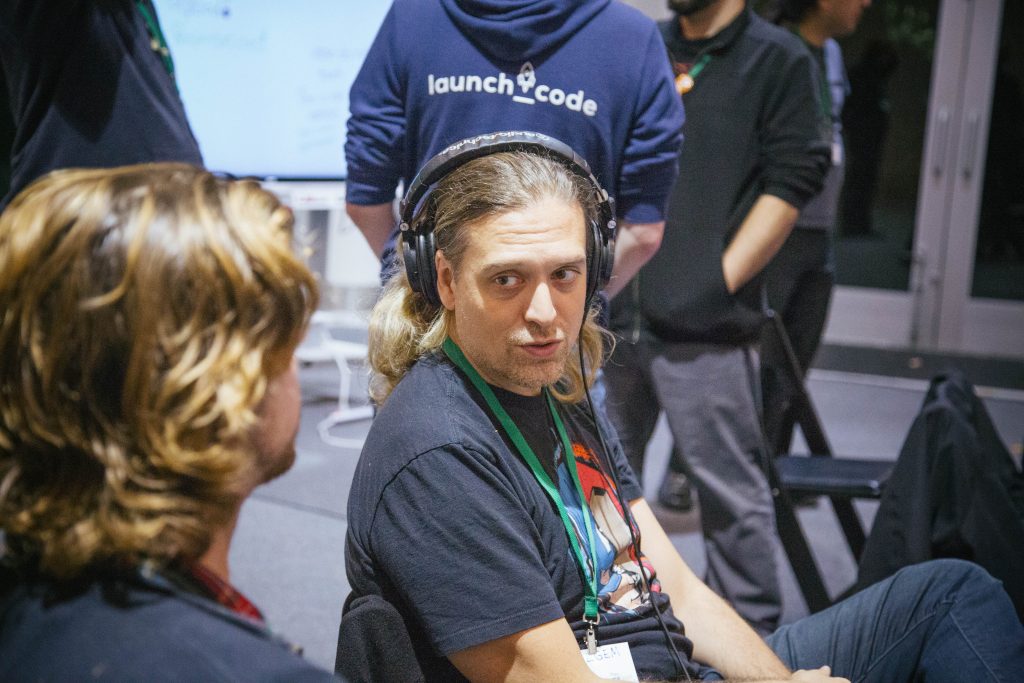
SATURDAY, 7 PM
The event organizers brought in pizza. Dinner provided an opportunity for game jammers to chat about their work progress or just to hang-out. The atmosphere was palpably positive! Everyone celebrated the amount of progress they had made in just 24 hours. Some were in a minimum viable product state! Everyone mutually celebrated each other’s progress. Everyone had made such progress in less than 24 hours! It was a very positive environment to be in!
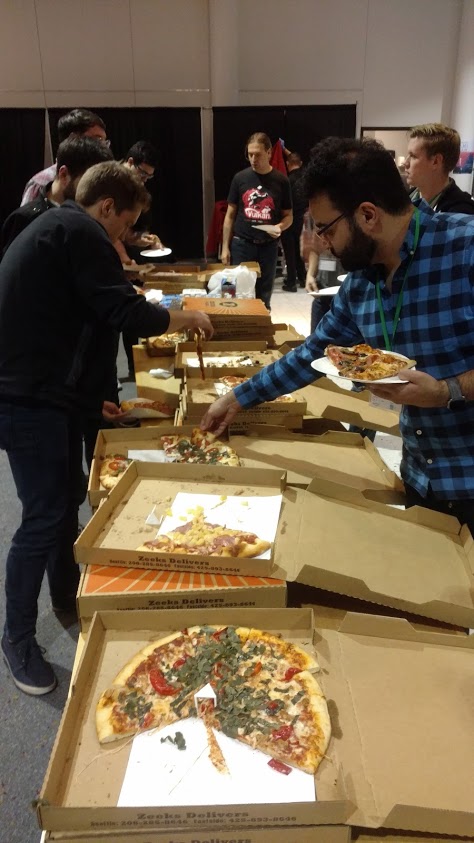
SATURDAY, 8 PM
Many game jammers returned from dinner to show off the status of their games:
The team had achieved a minimum viable product. Ray’s VR station was the first station guests saw as they arrived in the Ackerley Family Exhibit Gallery so he used this opportunity to show guests what VR was like and demonstrated the game. He provided status for the team: “The box is fully interactive, as intended. All design mapping is complete. We are now working on applying the textures to the [bare, wire-frame] room and adding in sound effects.” He also explained the game’s premise as “a VR game where you play a kid that time travels between three bathrooms – log cabin “old,” contemporary, and “futuristic” science fiction.”
Julie worked on art assets for Goblungee. She “finalized the environment’s color scheme, and also developed the first three thrown objects,” as well had working designs of Mr. Snootypants, a red dragon monster, and at around midnight was working on a goblin that would appear in the game. Olin “spent most of the day working on the physics for the bungee mechanic.” He said, “it’s important to get the core gameplay mechanics set as early as you can. Then our team can hopefully focus on polish tomorrow before the deadline.”
Steven had arrived late into the evening with his music and audio assets complete. With his primary role complete, he transitioned into a project management role to ensure that the rest of the team could operate successfully without running into roadblocks. He explained that the rest of his team were implementing his assets and bug-testing.
Steven continued by providing an overview of where other game jammers were at in their projects: “Some folks are probably experiencing burn-out at this time of day,” being almost midnight on Saturday. “You can see that some [teams] are gone. People are finally sleeping. This is the breaking point, Saturday night. The people that will keep going are going to get really discouraged tomorrow morning. They’ll sleep and get that moment of clarity to get their game out… or [any] game. [They’ll realize] it’s all about a simple idea that is enjoyable to play.”
Tentatively just titled “Spawn Salon,” the premise is that monsters bred inside of a salon. Customers drop off their monsters and ask for mutations or variations. The monsters can be combined or cloned and then sent back to customers or swept into a pit and disposed of… politely! They had a viable product and were fortunately not running into noteworthy production issues.
Ed summarized the game as “you break out of a room and try to find hidden messages in a series of hallways that may or may not be possessed by baddies.” They had a playable demo at this time but everything was still rough, including navigation, the text within the hidden messages, and a stubborn door that wouldn’t quite open.
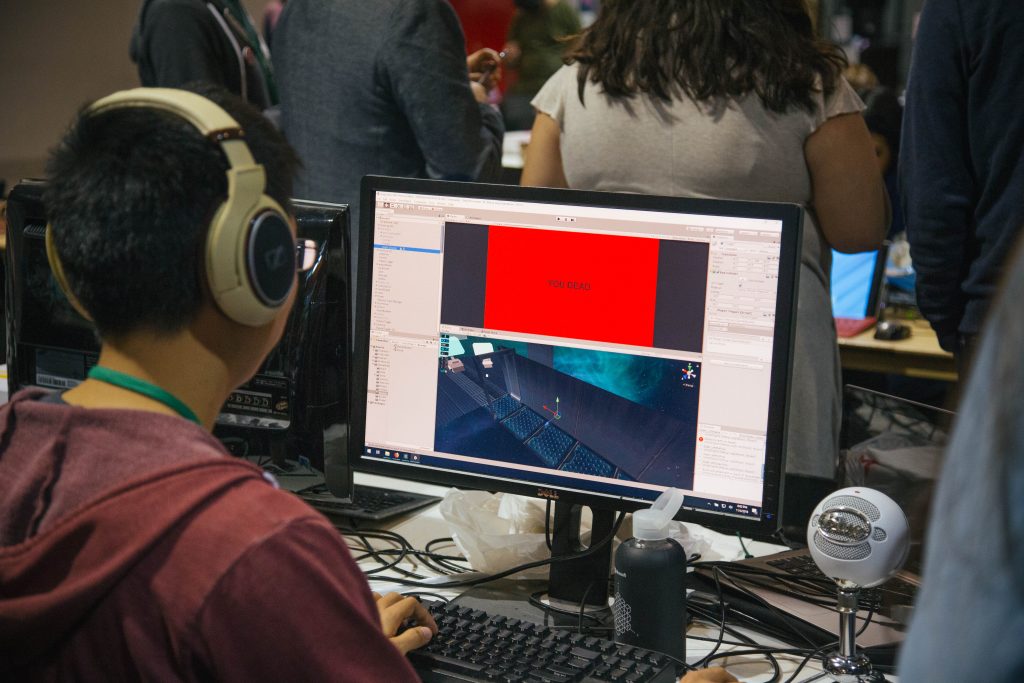
Craig summarized the game as “a cerebral experience where you uncover what’s going on as you progress through the level.” They had two instances that they worked on simultaneously. Craig’s instance was a bare, wire-frame pathway somewhat resembling a brain with floating boxes that would show messages when the player interacted with these boxes. TJ was working on a level that appeared nicely-textured.
Jami summarized the game as “a VR game where you teleport around a topsy-turvy world to get the prize like a flower and explore the field. There is a yellow light-type creature that follows you around and trees that are floating in the air.” They had a rough demo available for testing, but they were still sorting out some of the details about boundaries and invisible walls.
Pouria summarized the game as “a three-player competitive tank racing game with doors that would randomly move you around the screen and items that would either help you or help your opponents.” They spent most of Saturday polishing the gameplay and mechanics, so warping between doors was intuitive. At this point in Game Jam, Pouria actively looked for playtesters and fielded constructive criticism.
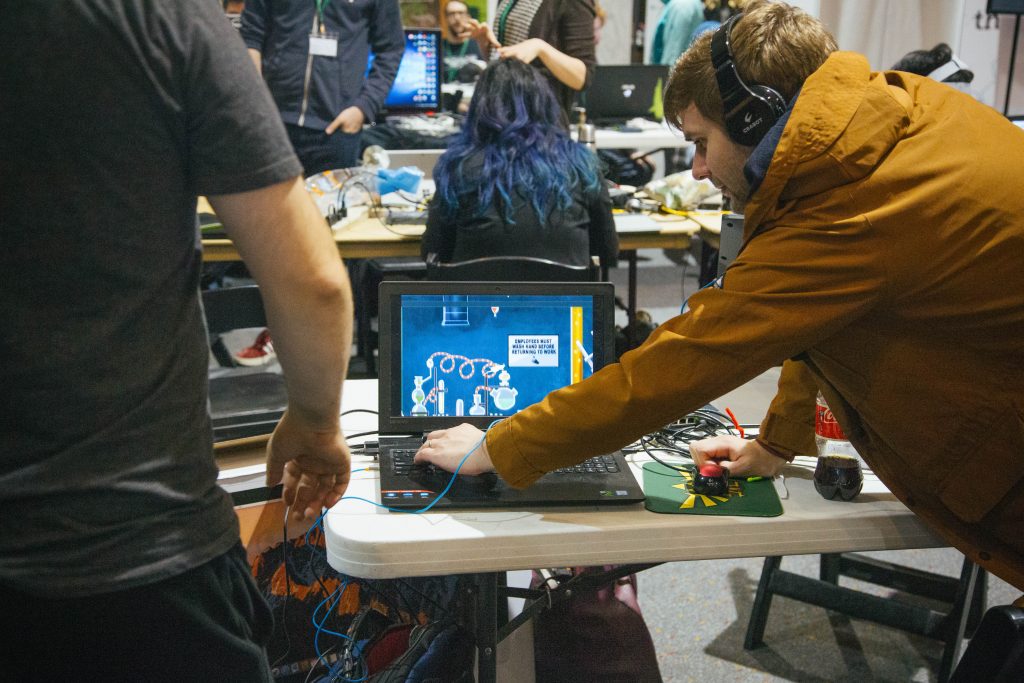
SUNDAY, 2AM
Almost all of the teams had packed up for the evening.
Ray took a break from testing out gameplay mechanics to provide a status update. They had realistic textures on the walls and had also added a sense of urgency to the game with the addition of a lockbox on top of the cardboard box time machine. The lockbox has three numbers that you can spin to reveal a prize. As a fun aside, Ray asked volunteers Chris and Anthony for a 3-digit number. Chris responded with an area code in the Seattle area that ended up appearing in the final game!
SUNDAY, 7AM
Seven teams were hard at work. Maybe the extra hours they received from Daylight Savings Time helped?
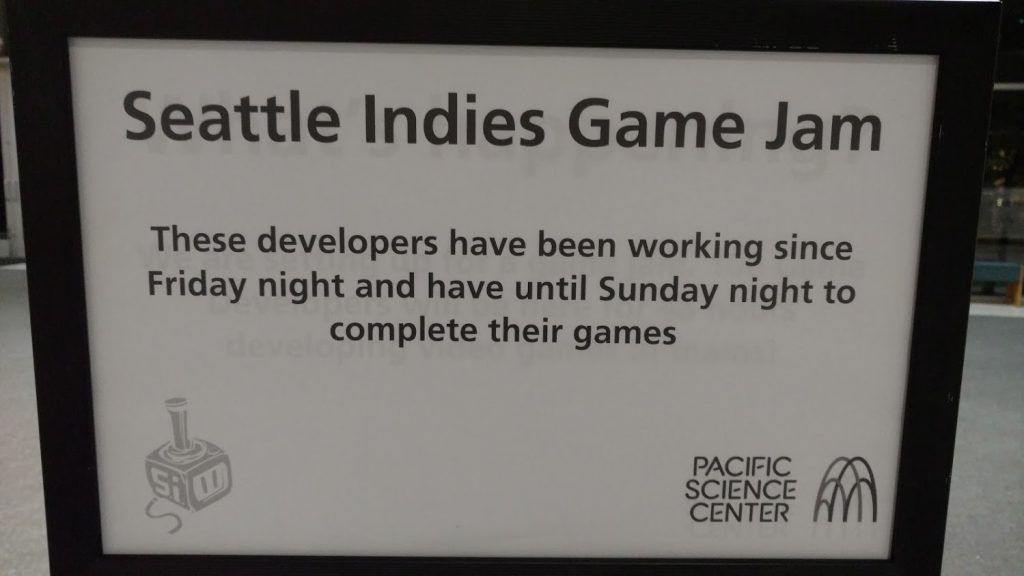
Budi had come up with an idea overnight of a game over screen and was implementing it.
Forrest and Ray were implementing Forrest’s sound effects.
TJ and Craig turned in early on Saturday to rest up. They were finishing work on combining their dialogue branches and texture branches into one finished product.
Pouria said their team had the same idea. They packed up early on Saturday to “get plenty of sleep to address any last minute issues or feature implementation ideas for our game.”
SUNDAY, 10 AM
Guests filtered in, along with the remaining game jammers. The event organizers brought in breakfast and coffee.
Clinton described his game as a “subversion of a zombie first-person-shooter game. The original idea was that it would be an off-rhythm rhythm game with crazy sound effects where you would heal your opponent with bullets.” Movements would have different sound effects than expected and reloading mechanisms were originally based on rhythm mechanics but might be changed before the final release.
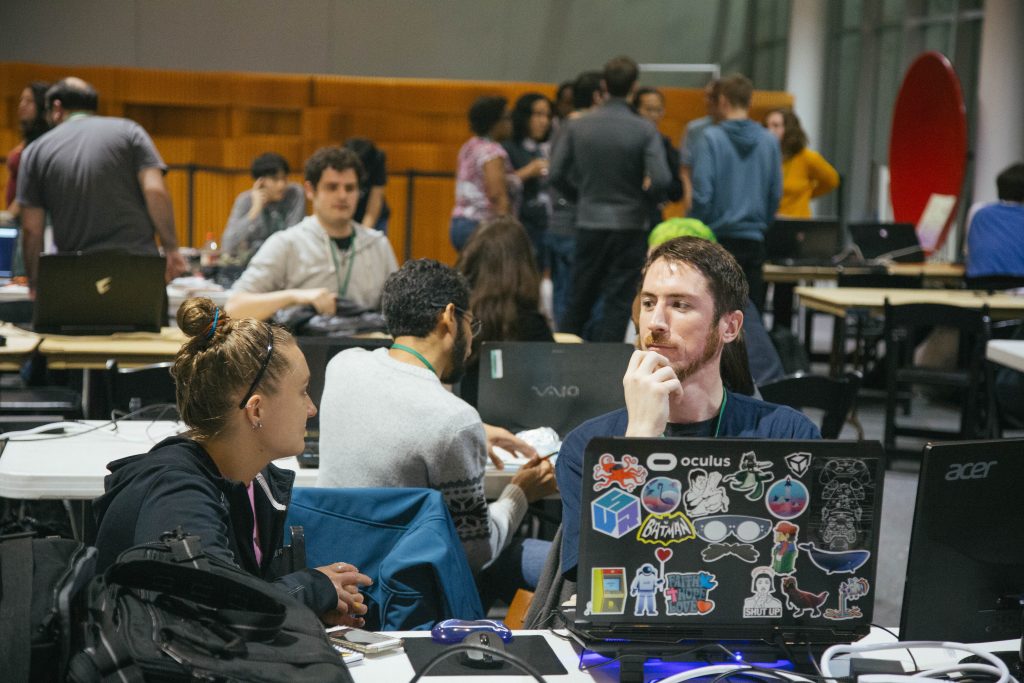
Craig and TJ ran into technical problems with their cerebral game. The hard drive in Craig’s laptop stopped working, but they were able to keep working after TJ copied the data from Craig’s laptop over to his laptop to merge their builds. Craig’s laptop was down for part of the morning until a screwdriver and some ingenuity of moving the hard drive to a different bay in Craig’s laptop resolved the issue.
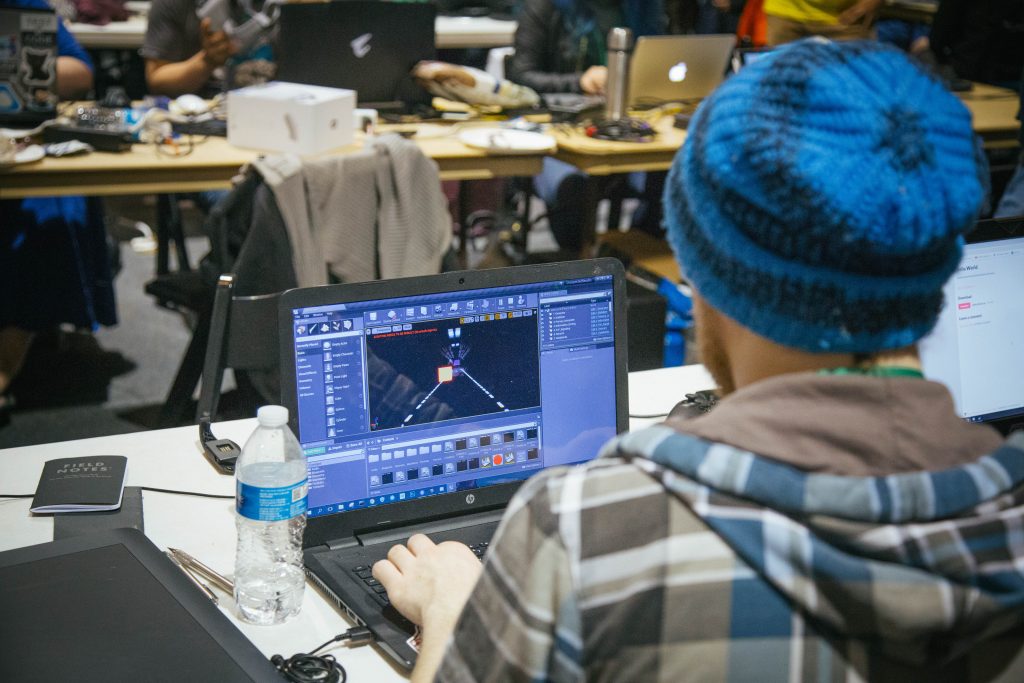
Ed was pleased. They successfully added audio and everything was coming together. He was concerned over aspects of the level design, but their minimum viable product played through hallways of an environment looking like an air duct without running into any major issues. The graphics had a distinctly retro, 90s aesthetic with fuzzy pixelated blocks to differentiate paneling.
“The objective of the game is to find multiple text boxes.” Ed continued by explaining that “one of the last changes to the game is swapping out the text,” which featured silly grammatical phrasings. To this point, interviewer Anthony asked, “so, the game has a lo-fi graphical aesthetic… and… a lo-fi grammatical aesthetic?” Nick and Anthony were both amused by this, but Ed explained, “we need to take out these text boxes. Even though that is funny, we need the text to be clear because the text is integral to understanding the plot of the game.”
The team had made significant progress in their build and were intently focused at this point.
The team had a minimum viable product running of their game. The team showed a quick demo of their game, which is a random item builder that, as Spencer described, “practices material detachment.” The idea is that objects, like cars or fire hydrants, drop from the ceiling and the player combines them into ways that will yield the best possible score after the object is launched out of a window.
Pouria showed a polished demo of the game. Later on, Abdullah with Amazon stopped by to check in with the Seattle Indies, and talked with the Baffled Brawl developers.
Tentatively called “A Cat Named Otto,” story designer Riley described their game as “a 2D cat platformer where the cat races through a maze in a series of increasingly complex artistic and narrative choices.” Max, one of Riley’s teammates, provided some useful advice for future game jammers. “After completing work on sound design, rather than sit around, I picked up the role of project manager on the team.” He said that “more teams need dedicated project managers to make sure that everyone remains on target.” This was echoed earlier by Steven, after he completed his audio assets for Goodnight, Rowan, and later by Josh after he completed his art assets for Time Mashine.
Tentatively called “Squeak,” or the more difficult to pronounce “Squeak Switch,” Cami explained that their levels were nearly complete, they just needed to add assets. They picked the title based on the colloquial term for a genetically modified mouse, or “a knockout mouse.”
Olin had the final name chosen and nearly had everything wrapped up. Jules “added to the level design, made the scoreboard, added to snootypants and am now working on the title card.” Cameron was “working on making a good wind sound for when the bungee jumper is falling. Easier said than done!”
Jacob worked on the soundtrack song throughout the jam: a whimsical tone representing the wizard while a woodblock rhythm represented the cowboys. The remainder of the 6-person team, led by veteran game designer Robert Rood, were focused on refining gameplay mechanics in preparation for crunch time.
SUNDAY, 4 PM
Crunch time. Everyone was focused on wrapping up their game before the 6 PM deadline.
SUNDAY, 6 PM
The event organizers brought in a celebratory burrito dinner! After dinner, everyone met in the auditorium for presentations, which were streamed on Twitch, and later uploaded to YouTube.
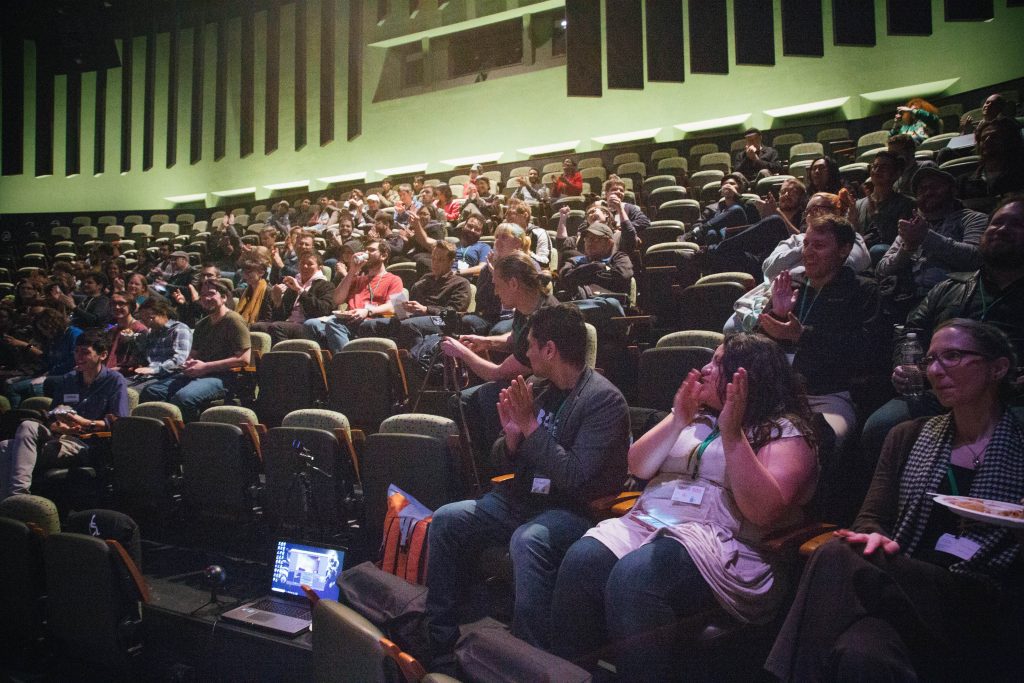
SUNDAY, 10 PM
The winners were announced!
- Judge’s Choice: Smiling at Neighbors
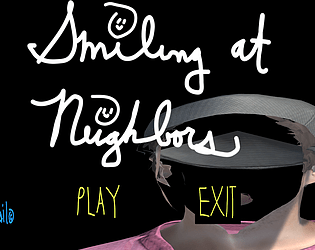
- Community Choice: Deleveled
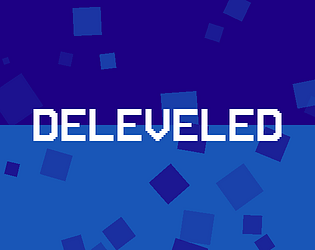
Judge’s Honorable Mentions:
- Theme: Hooked

- Art: Goblungee
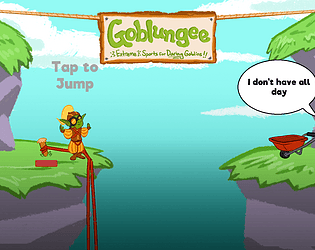
- Technical Execution: Dr. Sticky’s Spawn Salon
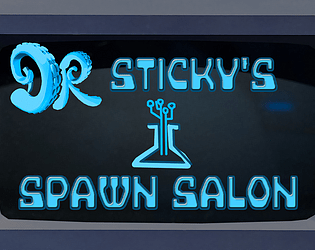
- Design: Baffled Brawl
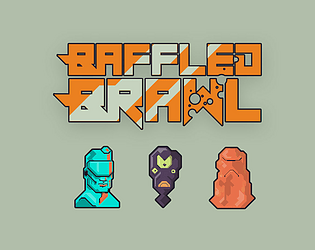
- Sound/Audio Design: Goodnight, Rowan

From here, everyone helped put away the network equipment, tables, and chairs, before departing with newly-completed games and newly-made friends!
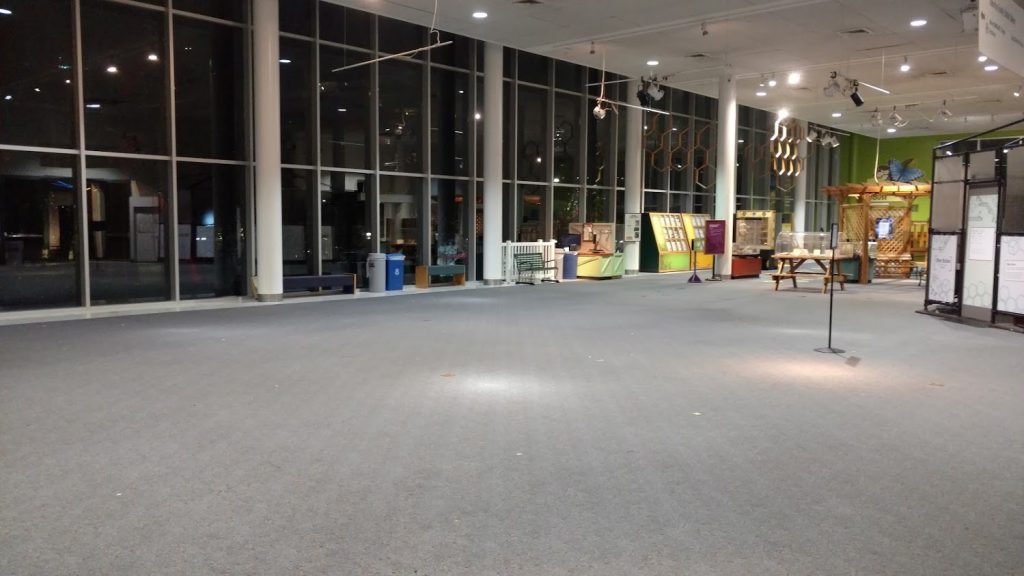
There were a few unexpected results from Game Jam.
One of the most unexpected results of this year’s Game Jam was the sheer number of high-quality games that were completed in those two days.
What was expected, however, was the level of professionalism and care provided by Pacific Science Center staff to everyone attending! The environment was overall positive, with Seattle Indies survey results including: “This entire event was fantastic! People, food, and space were all great!” “I love the people. The hosts, the attendees, the judges were all very respectful and helpful. It was really nice to have judges that could serve as mentors. Thank you so much for providing food as well.”
Some additional unexpected results:
– When asked about whether the Baffled Brawl team would continue working on their Game Jam project, Erfan Dastournejad said, “yeah we’re planning to release a Nintendo Switch version, hopefully by Christmas!”
– Goodnight, Rowan and many of the other games made at Game Jam were well received at the Seattle Indies Show and Tell.
– In the evening after the Seattle Indies Show and Tell, a Twitch live-streamer with an average of eight thousand viewers, Vinesauce, serendipitously played all of the games from Game Jam and seemed to enjoy all of the games that were made. That video was later uploaded to YouTube.
The second-annual Game Jam was a great opportunity for game developers of all skill levels to meet new friends, network with professionals, and work together on experimental games.
Thanks to Pacific Science Center, the Seattle Indies, and our sponsors for making all this possible!
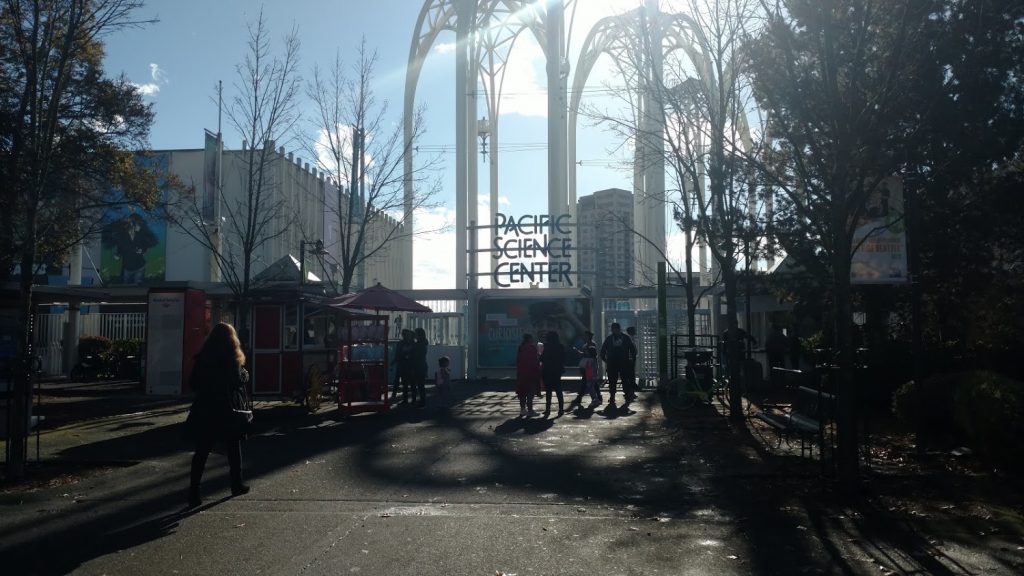
Seattle Indies is non-profit organization dedicated to fostering a vibrant and inclusive community of independent game developers in the greater Puget Sound area. Our primary focus is on hosting events and activities that empower people to make games, share feedback, network, and showcase their projects. We also strive to provide friendly spaces where developers can congregate for support, discussion, and news on game development, in addition to highlighting the works of our talented creators to the general public.